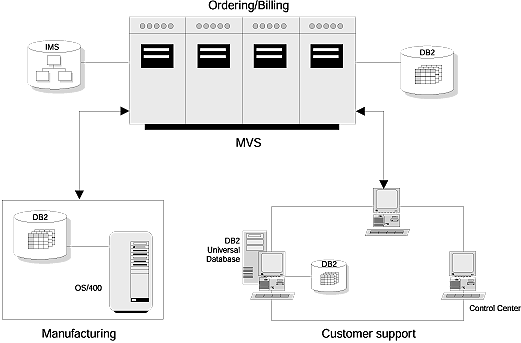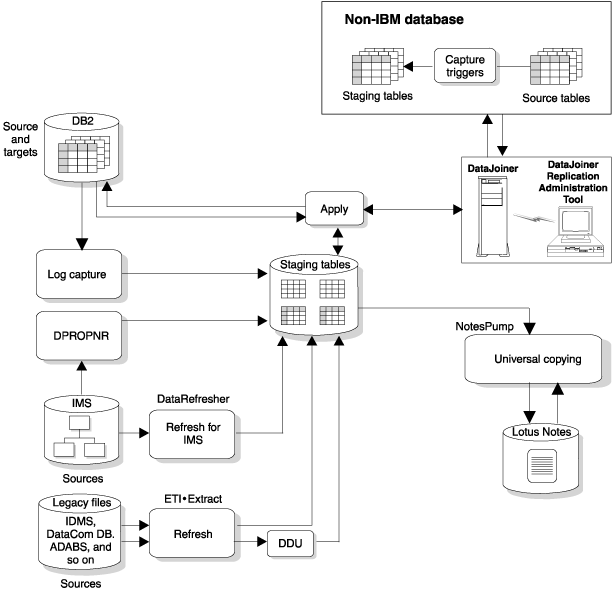

IBM Replication is a set of easy-to-use, automated copy tools that replicate data from sources to targets. Data can be copied:
You can tailor or enhance data as it is copied and deliver detailed, subset, summarized, or derived data when and where it is needed. You can use IBM Replication to define, synchronize, automate, and manage copy operations from a single control point for data across your enterprise. Figure 1 shows an example of data replication between various servers.
Figure 1. IBM Replication Tools. The IBM Replication tools copy data across an enterprise. 
By supporting sources and targets that include the DB2 family, IMS, VSAM, Oracle, Sybase, Microsoft, and Lotus Notes, IBM's solution ensures that you have timely, reliable, and consistent data across your enterprise.
IBM's architecture is built on standard SQL to leverage the database engine capabilities for data enhancement, network connectivity, and data security. IBM database support for distributed relational database architecture (DRDA) enables replication to other DRDA application servers.
An architected data staging area supports interoperability among multivendor databases, between heterogeneous data models, and among products from independent software vendors.
Figure 2 illustrates how IBM's replication solution supports heterogeneity in replication environments.
Figure 2. IBM's Data Replication Solution and Product Environment
 |
The IBM Replication tools capture source data from DB2 and IMS. Captured data for copying is placed into staging tables before the Apply program reads the tables and copies the changes. Updates need to be captured only once. You can stage the updates at any number of intermediate sites, which allows for flexible data distribution.
The Apply program filters, enhances, and replicates data to the target databases. DB2 DataJoiner enables the Apply program to read from or write to multivendor sources and targets. NotesPump acts as an alternative Apply program for multivendor, ODBC, and Notes targets.
DataPropagator NonRelational and DataRefresher provide a coordinated replication solution for IMS data sources, by bringing IMS, VSAM, and flat file data into the staging area, making it available for replication to client/server targets. You can use DataRefresher to copy data (full refresh copy) from IMS to DB2. You can use DPROPNR to capture changes from the IMS log and replicate them to a DB2 staging table. Replicating from IMS to DB2 makes it possible to implement decision-support applications that use relational technology. You can replicate to a staging table on DB2 for OS/390, which allows IBM Replication to further filter, enhance, distribute, and apply the data to relational databases across your enterprise.
In addition to IMS sources, DataRefresher can also copy data from VSAM and flat file sources. DataRefresher produces data extracts in load-ready format for any DB2 database and for both user tables or data staging area targets. The Data Difference Utility (DDU) can then detect recent changes in these DB2 load files and propagate these changes efficiently.
You can use DataRefresher's GUI to specify data definitions and data extract requests. You can then share the definitions and requests with DataPropagator NonRelational to replicate changes from source to target databases.
IBM's DB2 DataJoiner extends replication to multivendor sources and targets including Oracle, Sybase, Microsoft SQLServer, and others. DB2 DataJoiner is a multidatabase server that provides a new level of transparent data access. It can help businesses meet the challenge of efficiently accessing distributed data by enabling users to develop a virtual, enterprise-wide relational database.
DB2 DataJoiner provides a single-site image of all of your data, relational and nonrelational, local and remote, from IBM and non-IBM platforms, as though the data were local. DB2 DataJoiner masks differences in SQL dialects, data access methods, networking protocols, operating systems, and so on. For many businesses, replication is the mechanism of choice to improve access to data in heterogeneous environments. DB2 DataJoiner's advanced replication capabilities extend the benefits of homogeneous replication--reduced network traffic, enhanced data availability, better performance, and more data sharing--to heterogeneous environments. IBM Replication technology is integrated in DB2 DataJoiner to provide both synchronous and asynchronous access to data. DB2 DataJoiner provides continuous update replication, point-in-time replication, and integrated replication administration that streamlines the replication process.
Lotus NotesPump provides data replication between relational database management systems, ODBC accessible data stores, and Lotus Notes databases. NotesPump can copy data bidirectionally between supported data sources.
When used alone, NotesPump refreshes the target data from a direct query of the source data. NotesPump Release 2 understands the IBM Replication staging area architecture, and can act as an alternative Apply program to apply changes to multivendor, ODBC, and Notes data stores.
For example, to replicate DB2 data to Notes, you can use IBM Replication to capture the changes and create a staging table. Then, NotesPump can read the changes from the staging table and apply the changes to a Notes database.